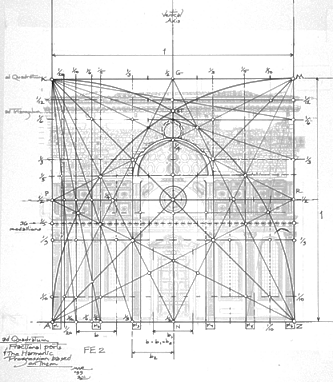
| A New Geometric Analysis of the Pazzi Chapel in Santa Croce, Florence |
|---|
667 Miller Avenue
Mill Valley, California 94941 USA
The Pazzi Chapel has long been the subject of speculation concerning its builder or builders, the limitations of its construction within the Santa Croce complex, and, most importantly, the geometric systems that are or are not present in the building. Correct analysis is a difficult task, although it may appear to be easy, given the proportioning that is seen and the number of theories that abound on the subject from the annals of art and architectural history. For me, the procedure is always to erase preconceived notions and to approach the work to be analyzed as if it were a secret treasure; the goal is to find the geometry within.
The Pazzi Chapel is based on the square and its three major divisions: rational whole numbers and fractional parts; square roots and irrationals; the special case of the irrational, the golden section 'family'. The builder also used the square's relationship to the circle and to the equilateral triangle. These three elements exist as the one unifying force in the architecture of the chapel. The artistry was in the integration of these three geometric systems.

As I measured the chapel, I recalled the opinions of those who have said that there is no golden section ratio in the chapel, or that, because no golden section relationship could be found in the chapel, there was no geometric system at all! The golden section may not be the epitome of all proportioning, but we still must concede its use if we find it. As we have seen, the measure of the floor plan was in the 3:5 measure of the walls and did not yield the f ratio. This was not to be the case with the altar space. It seemed logical to me, as a geometer, that if this particular relationship were to exist in the chapel, it would be in the floor plan of the main hall or the floor plan of the altar. My hunch proved to be correct; however, f showed up in an arcane geometric construction. I say arcane because it is not a commonly known ratio or geometric construction. It is:
This is the compound rectangle that is composed of the double square and the golden section rectangle. It is the direct development of a line segment divided into mean and extreme ratio using the diagonal of the double square. An additional construction that will also yield this 1.118…to 1 ratio is the double root-5. The tangency will be on the long sides of the rectangles. Here then are the measures:
The altar space width: 16.354 ft. = 196.25 in.
The altar space depth: 18.25 ft. = 219 in.
The ratio of depth to width: 219in. ÷ 196.25 in. = 1.1159… to 1
The percent deviation form the 1.118… ( v5 ÷ 2 ) ratio is: -0.1896…% low.
ILLUSTRATION: The ad quadratum system applied to the facade of the Pazzi Chapel in Santa Croce, Florence.
ABOUT
THE AUTHOR
Mark
Reynolds is a visual artist who
works primarily in drawing, printmaking and mixed media. He received
his Bachelor's and Master's Degrees in Art and Art Education
at Towson University in Maryland. He was awarded the Andelot
Fellowship to do post-graduate work in drawing and printmaking
at the University of Delaware. For the past decade, Mr. Reynolds
has been at work on an extensive body of drawings, paintings
and prints that incorporate and explore the ancient science of
sacred, or contemplative, geometry. He is widely exhibited, showing
his work in group competitions and one person shows, especially
in California. Mark's work is in corporate, public, and private
collections. Mark is also a member of the California
Society of Printmakers (six of his images can be found on
their website by clicking on "Galleries" then scrolling
down to Mark Reynolds under "Artist Member Porfolios), the
Los Angeles Printmaking Society, and the Marin Arts Council.
A born teacher, Mr. Reynolds teaches sacred geometry,
linear perspective, drawing, and printmaking to both graduate
and undergraduate students in various departments at the Academy
of Art College in San Francisco, California. He was voted Outstanding
Educator of the Year by the students in 1992.
Additionally,
Reynolds is a geometer, and his specialties in this field include
doing geometric analyses of architecture, paintings, and design.
He published, "A
Comparative Geometric Analysis of the Heights and Bases of The
Great Pyramid of Khufu and The Pyramid of the Sun in Teotihuacan",
in The Nexus Network Journal, vol. 1, no. 4. Mr. Reynolds is
also contributing editor for the "Geometer's
Angle" column in the Nexus Network Journal. He
lives with his wife and family in Mill Valley, California.
|
Mark Reynolds, "A New Geometric Analysis of the Pazzi Chapel in Santa Croce, Florence", pp. 105-121 in Nexus III: Architecture and Mathematics, ed. Kim Williams, Pisa: Pacini Editore, 2000. http://www.nexusjournal.com/conferences/N2000-Reynolds.html |
|
|
|
|
